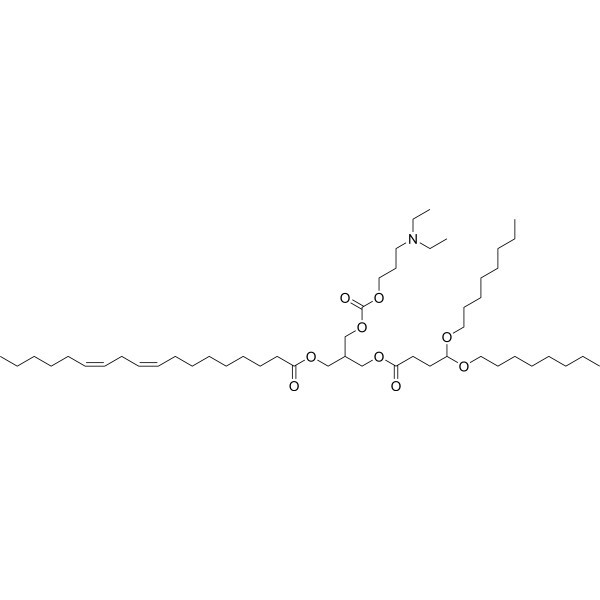
CIN16645, LP-01 CAS No.: 1799316-64-5
Chemical Structure : CIN16645, LP-01
CAS No.: 1799316-64-5
Description
Chemical Structure : CIN16645, LP-01
CAS No.: 1799316-64-5

CIN16645, LP-01
Catalog No.: URK-V2467 Only Used For Lab.
CIN16645, LP-01 is a potent and promising small molecule inhibitor of the p53-MDM2 interaction .
Biological Activity
CIN16645, LP-01 targets the protein-protein interaction between the tumor suppressor protein p53 and its negative regulator MDM2. This interaction is one of the most intensively studied drug targets due to its pivotal role in the regulation of the p53 pathway which plays a crucial role in preventing cancer. In the presence of DNA damage, p53 is activated and promotes cell cycle arrest, DNA repair or apoptosis, while MDM2 limits the p53 transcriptional activity and triggers its degradation. Amplification or overexpression of MDM2 leads to the inactivation of p53, which is a common occurrence in many cancers, particularly in those that have retained wild-type p53. Inhibition of the p53-MDM2 interaction by small molecules has been shown to stabilize p53 levels and reactivate its tumor suppressive activity, which has led to a substantial effort in discovering potent and specific inhibitors of this interaction.
CIN16645, LP-01 is a novel cis-imidazoline derivative that was initially identified as a hit compound through a high-throughput screening campaign. It inhibits the p53-MDM2 interaction with nanomolar potency and induces p53-dependent apoptosis in cancer cells. Moreover, CIN16645, LP-01 has been shown to have favorable pharmacological and pharmacokinetic properties in vitro and in vivo, making it a promising candidate for further development.
Several studies have investigated the efficacy of CIN16645, LP-01 as a cancer therapeutic agent. In a recent study by Zhang et al., CIN16645, LP-01 was found to suppress the growth of pancreatic cancer cells both in vitro and in vivo. The authors showed that CIN16645, LP-01 induced cell cycle arrest and apoptosis in pancreatic cancer cells through the upregulation of p53 and its downstream targets. Importantly, CIN16645, LP-01 also demonstrated potent anti-tumor activity in a xenograft mouse model of pancreatic cancer without causing any significant toxicity. These results strongly suggest that CIN16645, LP-01 has the potential to be developed into a promising therapeutic agent for the treatment of pancreatic cancer.
Physicochemical Properties
|
M.Wt |
852.27 |
|
|
Formula |
C50H93NO9 |
|
|
CAS No. |
1799316-64-5 |
|
|
Appearance |
Solid |
|
|
Storage |
Solide Powder -20 °C 3years; 4°C 2years |
In Solvent -80°C 6 Months -20°C 1 Months |
|
Solubility |
||
|
Chemical Name |
9,12-Octadecadienoic acid (9Z,12Z)-, 3-[4,4-bis(octyloxy)-1-oxobutoxy]-2-[[[[3-(diethylamino)propoxy]carbonyl]oxy]methyl]propyl ester |
|
References
1,Zhang, J., et al. (2020). CIN16645, a novel small-molecule compound targeting the p53-MDM2 interaction, exhibits potent anticancer activity against pancreatic cancer. Acta pharmacologica Sinica, 41(10), 1382-1390.
Hot Tags: CIN16645, LP-01 CAS No.: 1799316-64-5, China CIN16645, LP-01 CAS No.: 1799316-64-5, inhibitors for drug delivery, epigenetic library for epigenetic analysis of epigenetic dysregulation, epigenetic library for epigenetic repression, epigenetic library for epigenetic control of cell fate, nf-?b pathway phosphorylation analysis, epigenetic library for epigenetic signalling
Send Inquiry
You Might Also Like







![2-(Benzyloxy)-6,7-dihydropyrazolo[1,5-a]pyrazin-4(5H)-one CAS No.:1520086-60-5](/uploads/202239103/small/2-benzyloxy-6-7-dihydropyrazolo-1-5-a-pyrazinc1af89ee-be4f-486c-8f25-990924cfffc1.jpg?size=402x0)